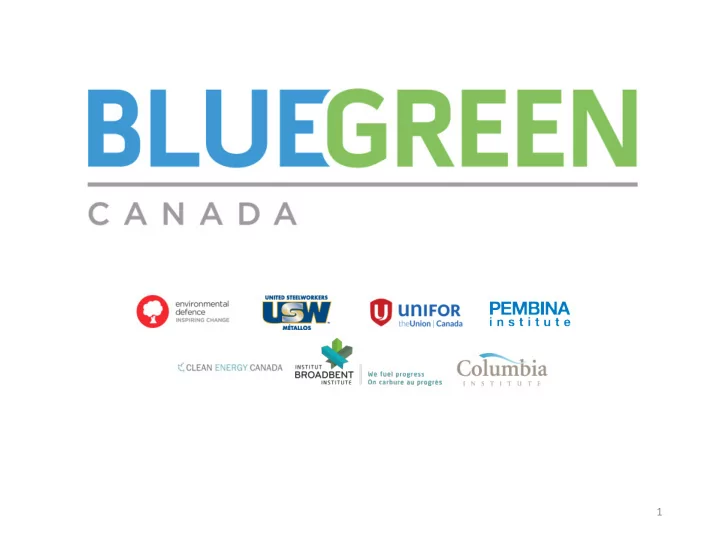

1
Relying on volatile commodities is risky – Revenue rollercoaster Petro-dollar hurts manufacturing If subsidies to oil and gas ($1.3B) were invested in renewables and energy efficiency we would create 18,000 more jobs
• Blue Green Canada and BGA (US) wrote companion letters to the US and Canadian governments • Without Just Transition and Decent Work language in the operational portion of the Paris agreement, the cost for the transition to a low- carbon society would be unfairly born by working women and men. • Agreement must ensure a just transition of the workforce and creation of decent work and quality jobs
In our conversations about the coal phase-out, workers recognize the need to address the climate impacts of coal and other industries. They are also looking for certainty and plans that will help them to continue to work and support themselves and their families.
The (former) Alberta Government’s plan to support workers and communities in the transition from coal is an important piece toward providing certainty and successful transitions for Albertans.
So what does all this have to do with “Sustainable Pathways for Canada’s Onroad Transportation Sector”?
The Companies
The Government(s)
Workers,Communities,& Allies
Far too often plans are made without everyone at the table
www.canada.ca/en/environment-climate-change/services/climate- change/task-force-just-transition.html
Just Transition Task Forse seven principles for a just transition : 1. Respect for workers, unions, communities, and families; 2. Worker participation at every stage of transition; 3. Transitioning to good jobs; 4. Sustainable and healthy communities; 5. Planning for the future, grounded in today’s reality; 6. Nationally coherent, regionally driven, locally delivered actions; and, 7. Immediate yet durable support.
Transition to a Green, Fair, and Inclusive Economy Climate change is the signature challenge of our time. Left unchecked, climate change threatens the very future of civilization. But we are facing this urgent threat at a moment in history when we also face other great challenges including: growing economic inequality; increasing precarious work; reconciliation with indigenous people; and continuing discrimination against women, racialized persons, and the LGBTQ community. As we rise to meet the challenge of climate change, we must build an inclusive movement that addresses the needs of young people, indigenous people, workers, women, newcomers, and EVEN environmentalists. While our objectives must be idealistic, our proposals must be pragmatic and driven by science and sound policy making. We must start to plan now for well-managed and inclusive transitions to a low carbon future. It starts with people talking about what a fair, green future economy looks like, including communities and workers that have been historically disadvantaged, union members, and precarious workers in Canada. We have the power to find solutions so our economy is just, green, inclusive and fair.
There is a lot of work to do. We call on our leaders to: 1. Commit to take the actions needed to keep the global average temperature increase to less than 2 ℃ aiming for a maximum global temperature increase of 1.5 ℃ . 2. Ensure that no one is left behind as we transition to a green economy. 3. Take advantage of the huge opportunities to create wealth and jobs in the transition to a green economy, with a plan to create a low carbon industrial strategy. 4. Provide support to workers and communities directly and indirectly impacted by actions that reduce or eliminate processes that produce carbon pollution.
There is a lot of work to do. We call on our leaders to: 5. Invest to decarbonize electricity generation, our buildings, and our transportation systems in Canada. 6. Promise that all workers will be paid a living wage and have employment security protected in law. 7. Commit to massive long term investments in public infrastructure projects which are a necessary part of a low carbon future and will create jobs across Canada. 8. Correct the unfair and unaffordable economic imbalance between the ultra-wealthy and the rest of Canadian society with economic measures that will better share Canada’s wealth.
An Autoworker on ZEVs • It is important to identify the opportunity and value of attracting EV manufacturing to Canada – we build Mini Vans, SUVs, Cars in Ontario. The Hybrid Pacifica built in Windsor is the only EV built in Canada. Even in that case the vehicle propulsion/battery manufacturing is done outside Canada. • The biggest challenge is that the decisions made by auto manufacturers are made outside of the Canadian border. • GM, Ford, FCA, Toyota, Honda. New Flyer Industries in Manitoba are the exception.
• How do we encourage ZEV manufacturing in Canada? Can we build government and consumer support for ZEVs to encourage manufacturing? From Ken (auto worker)
Jamie Kirkpatrick , Program Manager www. BlueGreenCanada.ca @BlueGreenCA info@bluegreencanada.ca | 416-323-9521 Ext. 289 3 6
Recommend
More recommend